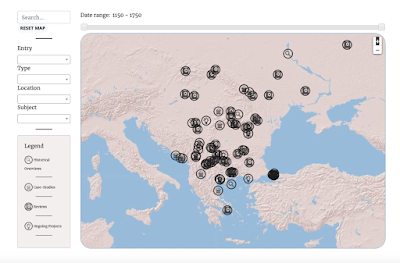Even though New York obviously has no original medieval buildings (except for those built into The Cloisters), the City is home to wonderful collections of medieval art.
The Metropolitan Museum houses the largest and best collection of medieval art in the US, much of it on display in the main building, while many more are on view at
The Cloisters, the branch of the museum devoted to the European Middle Ages.
The Morgan Library and the
New York Public Library house hundreds of valuable medieval illuminated manuscripts. (To see how many objects from medieval Hungary these collections hold, have a look at my
preliminary checklist). I had a chance to spend two days in New York this past week - instead of these permament collections, I seeked out some Medieval and Renaissance exhibitions, which I will briefly describe below.
 |
St. Mark preaching - Ivory panel from the
so-called Grado Chair, 7th-8th c. |
First on my list was the
Byzantium and Islam exhibition at The Metropolitan Museum, which actually closes today. This large exhibition is part of a series of shows curated by Helen C. Evans and dedicated to Byzantine Culture (a series which acutually started with Kurt Weitzmann's 1977 exhibition titled
The Age of Spirituality). The two earlier exhibitions - “The Glory of Byzantium” in 1997 and “Byzantium: Faith and Power” in 2004 - focused on later periods of Byzantine art (the Middle Byzantine period and the last centuries of the Byzantine empire, respectively), while the current exhibition goes back to the early centuries of Byzantium, exploring the vast southern part of the Empire. The focus is on the diverse cultural traditions (Greek, Coptic, Syriac, Jewish, etc.) and on the emergence of a new force in the region: Islam. The exhibition is arranged thematically, surveying first religious art of the Byzantine empire, then focusing on themes of secular art (such as commerce or dress), finishing with Islamic religious art. The
website of the museum gives a very good overview of the material on view, and more in-depth information is provided by tthe accompanying
blog.
While the earlier exhibitions mainly focused on highlights of Byzantine art - icons, luxury manuscripts, goldsmith works - and on the connections of Byzantium with western Europe and Latin Christianity, this exhibition was quite different. The exhibition looked to the Eastern and Southern neighbours of Byzantium, and raised a number of very interesting and novel questions about cultural transfer and the co-existence of different traditions. Naturally, the show also includes a number of truly spectacular items: such as the famous Rabbula Gospels from 586 or the wonderful ivories of the so-called Grado Chair. The narrative was clear, and the display - as always at the Met - was wonderfully arranged. Overall, however, I was not quite as impressed with this exhibition as with the 1997 "Glory of Byzantium" - the wonderful display of icons from the Monastery of St. Catherine at Mt. Sinai remains a vivid memory to this day from the earlier exhibition. Due to political circumstances, no loans arrived from Egypt this time. These objects, however, are included in the
catalogue - their presence would have definitely made the whole exhibition different.
 |
Head of a man.
Bohemian, 1360-1380 |
Currently, there is one more exhibition at the Metropolitan Museum focusing on Medieval and Renaissance art: titled
Dürer and Beyond, it displays Central European Drawings, 1400–1700. It starts with a few beautiful Bohemian drawings, well-known from the
Prague: The Crown of Bohemia exhibition (2005). In other parts of the museum, there are additional special displays, including the
Rylands Haggadah (mid 14th c., Catalonia),
Renaissance illuminations from the Robert Lehman Collection, and a handful of
Northern Italian paintings from the Accademia Carrara at Bergamo.






